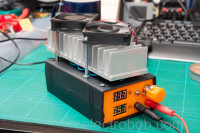PSU Burner

An advanced high speed power supply tester using the Analog Discovery to generate a test waveform and observe the power supply behaviour.
Take 2 There are some improvements, so let’s go through the schematic first. The way it works is simple: U1A will drive Q1 such that the voltage across R6 is equal to the reference at it’s positive input. This in effect creates a constant current being drawn from the test power supply.
In “external mode” the constant current load is controlled and read out by the Analog Discovery. Since the control signal can be up to 5V, with R5 being 0.1Ω, I have divided it 10 times using R2-R3, to limit the max current to 5A. In “internal mode” there is a fixed reference generated using RV1 and a 5V regulator, which makes the supply draw a constant, adjustable current.
For a nicer look, I added 2 meters, they are your typical 3 wire voltmeters, but make sure you get the nicer ones which auto-scale and use all 3 digits for precision under 10V which are also hackable. The current meter needs a 10X amplifier first, since we are reading current on a 0.1Ω resistor.
Finally, let’s look at the extra safety features: first, I am now using 5 transistors instead of 3, of similar type. I have added a rather large, 0.5Ω balancing resistor in each source, made by 2 1Ω/0.6W resistors in parallel (remember, built out of what I had in my component drawers). And second, a Zenner diode between the source and drain. This will serve 3 purposes: if the load is applied with reverse polarity, the fuse will blow and it will also protect the transistors from high peaks when a load is disconnected. Third, if more than 36V is applied, it will blow the fuse. The nice thing about using a Zenner like this: if a high enough current is passed through, it will melt and become permanently a short: it forms an anti fuse.
Oh, and did I mention I want it to be fast? Well, that is why I used a TL3472 (besides that I had one): it has a rather high slew rate and a high output current capability.
Full details at http://www.electrobob.com/psu-burner/
In “external mode” the constant current load is controlled and read out by the Analog Discovery. Since the control signal can be up to 5V, with R5 being 0.1Ω, I have divided it 10 times using R2-R3, to limit the max current to 5A. In “internal mode” there is a fixed reference generated using RV1 and a 5V regulator, which makes the supply draw a constant, adjustable current.
For a nicer look, I added 2 meters, they are your typical 3 wire voltmeters, but make sure you get the nicer ones which auto-scale and use all 3 digits for precision under 10V which are also hackable. The current meter needs a 10X amplifier first, since we are reading current on a 0.1Ω resistor.
Finally, let’s look at the extra safety features: first, I am now using 5 transistors instead of 3, of similar type. I have added a rather large, 0.5Ω balancing resistor in each source, made by 2 1Ω/0.6W resistors in parallel (remember, built out of what I had in my component drawers). And second, a Zenner diode between the source and drain. This will serve 3 purposes: if the load is applied with reverse polarity, the fuse will blow and it will also protect the transistors from high peaks when a load is disconnected. Third, if more than 36V is applied, it will blow the fuse. The nice thing about using a Zenner like this: if a high enough current is passed through, it will melt and become permanently a short: it forms an anti fuse.
Oh, and did I mention I want it to be fast? Well, that is why I used a TL3472 (besides that I had one): it has a rather high slew rate and a high output current capability.
Full details at http://www.electrobob.com/psu-burner/



Updates vom Autor